The Producer Price Index is where tariffs will show up first, whether or not companies can pass on those cost increases.
By Wolf Richter for WOLF STREET.
From mid-2024 through January 2025, before any new tariffs had been implemented, the PPI had shown substantial and accelerating inflation at the producer level – input costs for companies that they then try to pass on if they can. Most of those price increases occurred in services.
Today’s release of the PPI for March backpedaled on a month-to-month basis, pushed down by plunging prices of gasoline (-11% month to month), diesel, and jet fuel, dropping prices of foods (-2.1%, after February’s +1.7%), and dropping prices of an array of services, including final demand trade services (-0.7%), final demand transportation and warehousing services (-0.6%), machinery and vehicle wholesaling (-1.3%), airline passenger services, and retailing of food, apparel, jewelry, footwear, and accessories. Services dominate the PPI.
But some prices increased in March, including for steel mill products (+7.1% month to month); structural, architectural, and pre-engineered metal products; primary basic organic chemicals; plastic resins and materials; legal services (+1.5%); wholesaling of chemical products; and industrial electric power.
Overall PPI Final Demand: On a month-to-month basis, the PPI for March fell by 0.39% or by -4.6% annualized, the biggest drop since 2020 (blue in the chart below), which pushed down the 6-month increase to +2.3% annualized, the smallest increase in a year (red).
Just looking at the blue line in the chart, we see how much it jumps up and down. Any major drop into the negative was followed by a big jump, mostly the next month, or sometimes the month after. And that can be expected here too. This was one of those big dips that will be followed by a spike likely in April or maybe in May. That’s just how it is with volatile month-to-month data, which is why we’re more focused on the fat red line for the six-month rate.

On a year-over-year basis, the PPI rose by 2.7%, the second month in a row of deceleration:
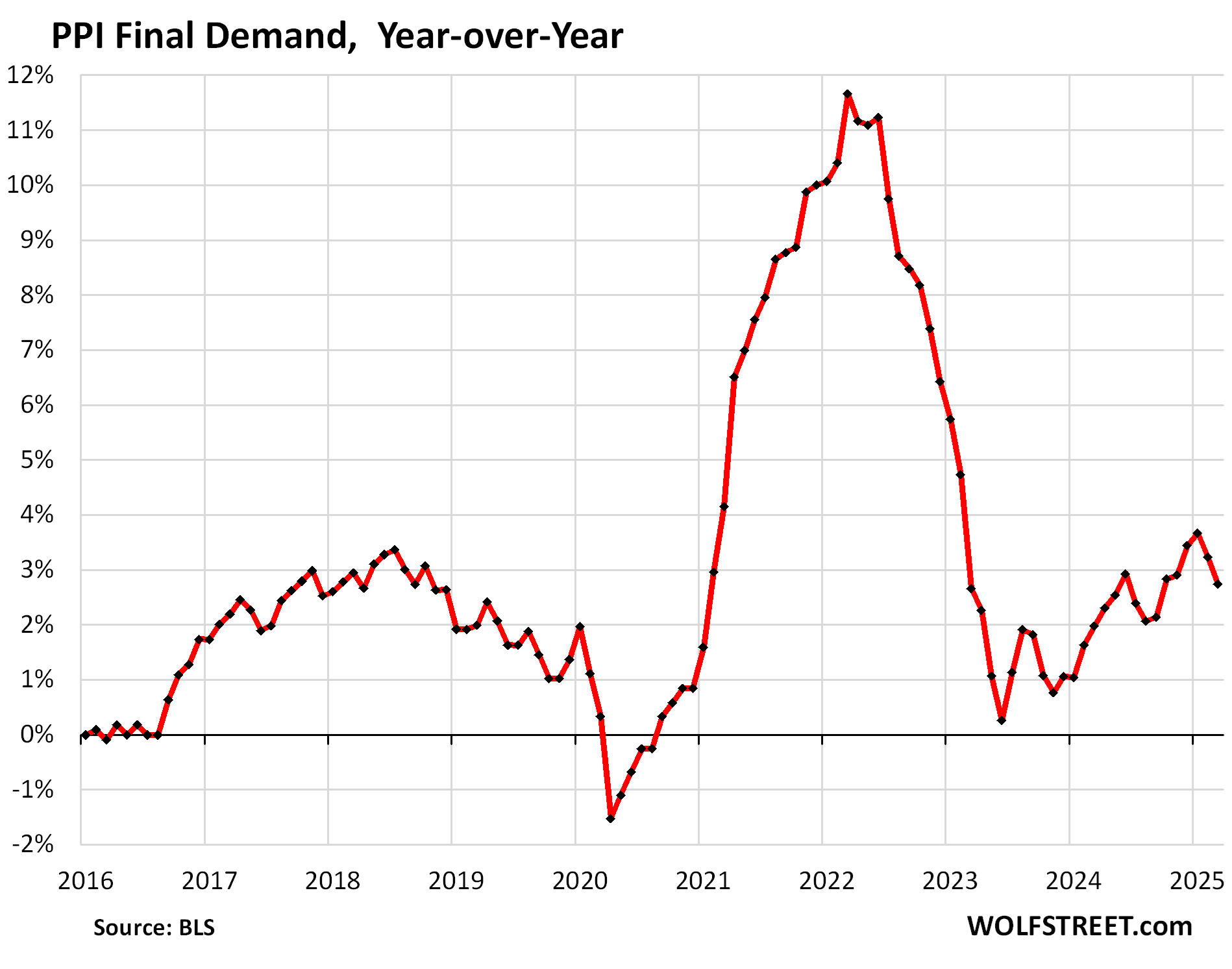
Without food & energy: “Core” PPI. Month-to-month, the core PPI for March fell by 0.07% (-0.7% annualized), which pushed down the 6-month increase to +2.3% annualized, the smallest increase since March 2024.
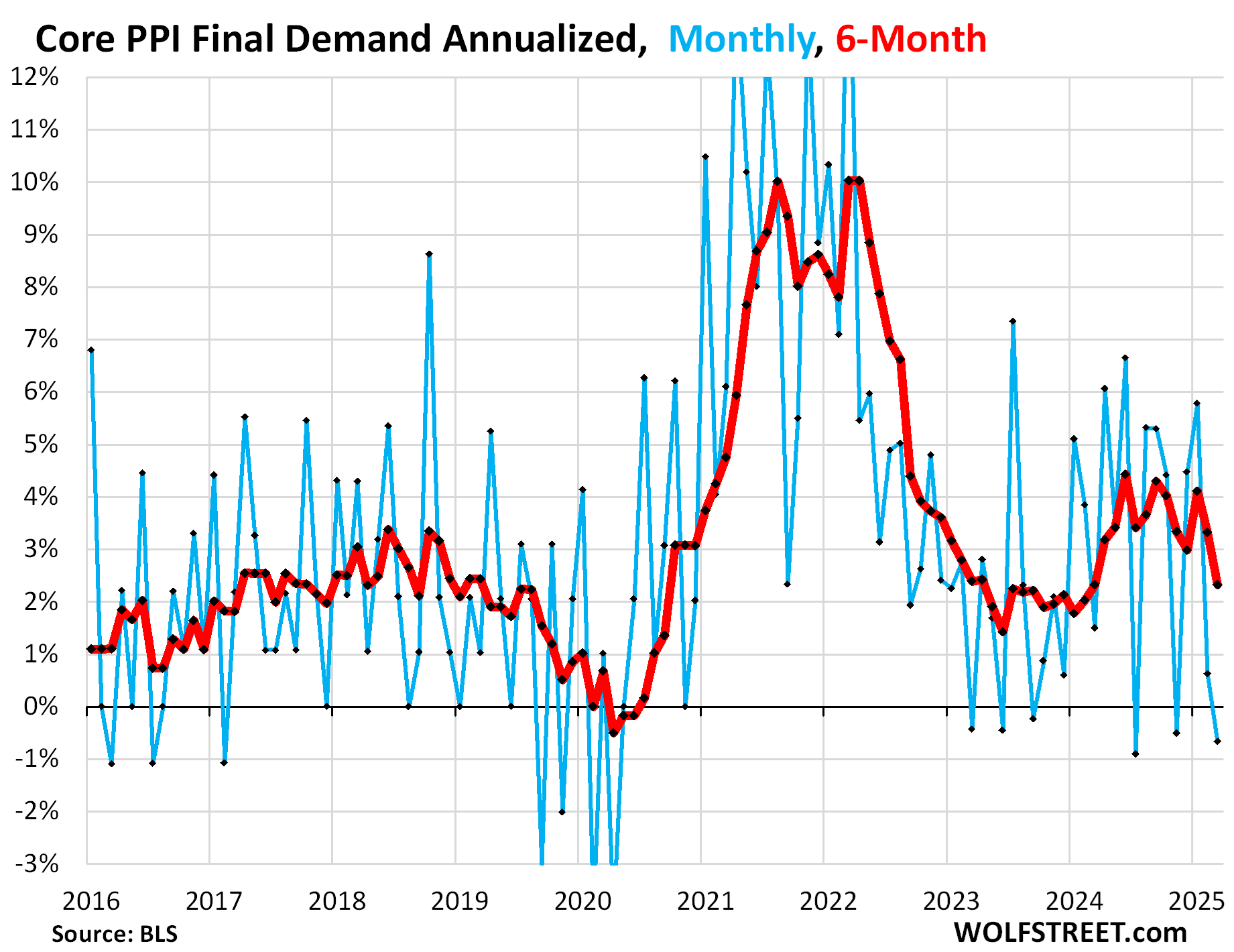
On a year-over-year basis, the core PPI rose by 3.3%, the second month in a row of deceleration:
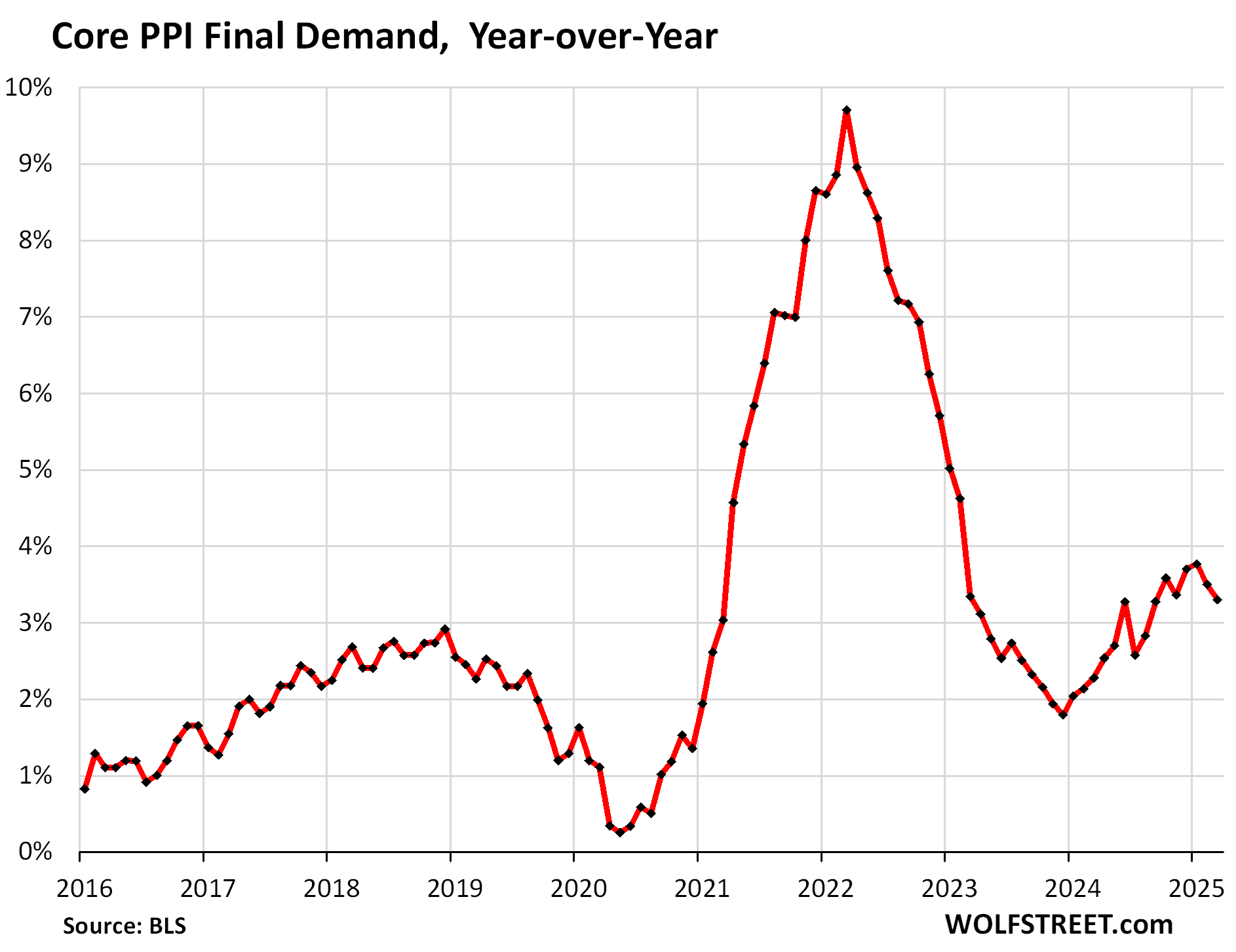
The services PPI, which accounts for 67% of the overall PPI, declined by 0.18% in March from February (-2.1% annualized), the second decline in a row, which pushed down the six-month increase to +2.3%, the smallest increase since February 2024.
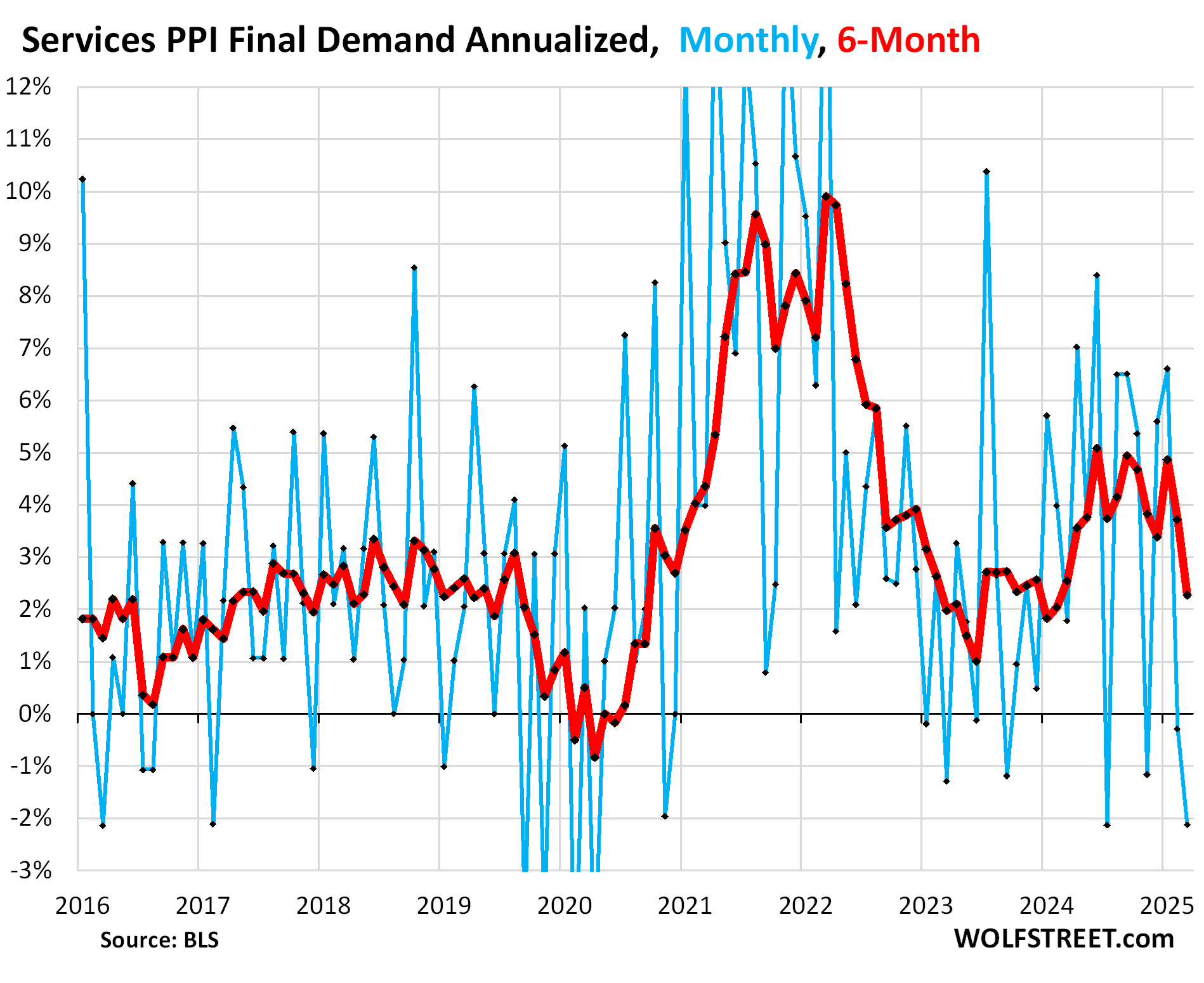
On a year-over-year basis, the services PPI rose by 3.6%, the second month in a row of deceleration:
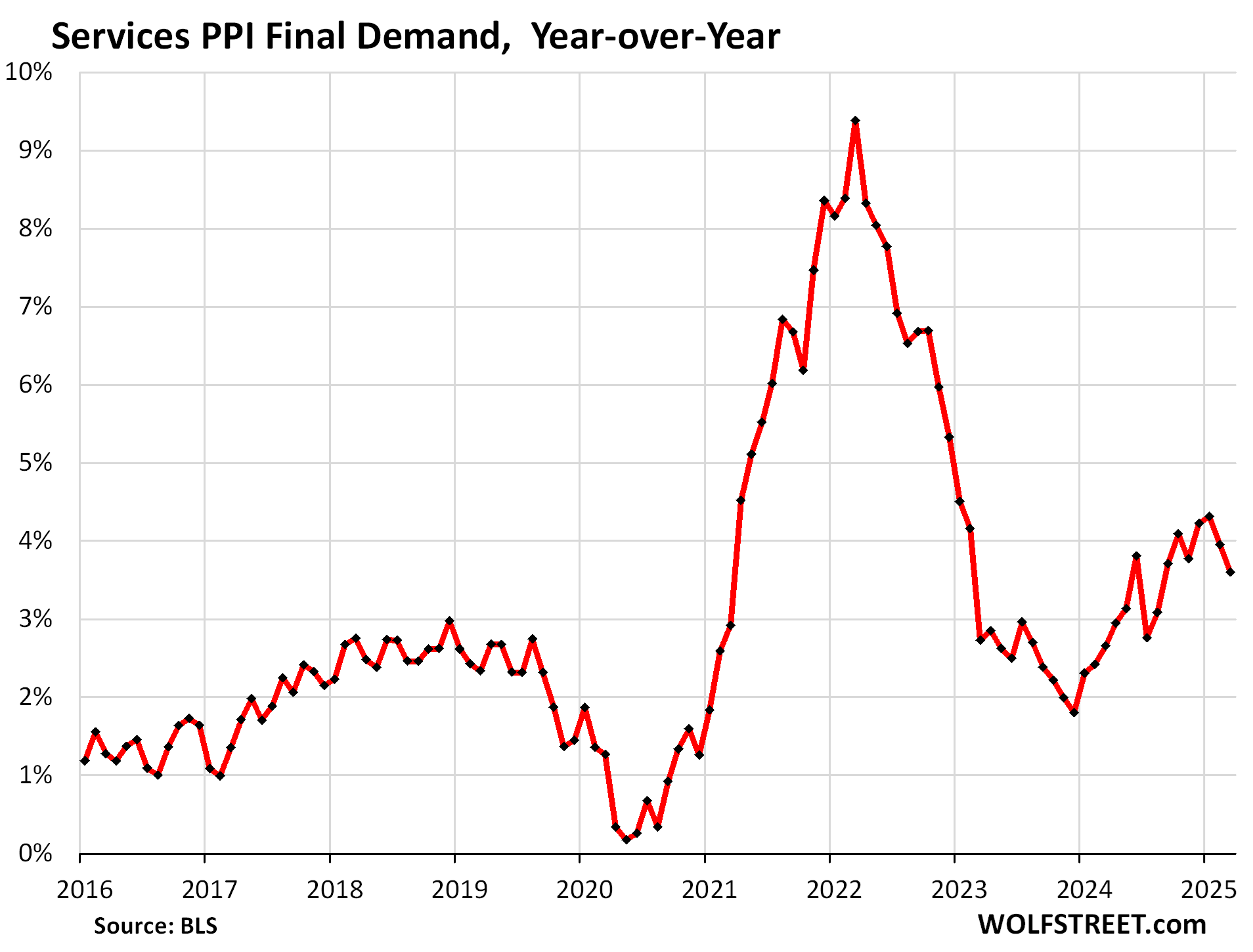
The “core goods” PPI final demand – which excludes foods and energy where prices plunged in March – rose by 0.32% in March from February (+3.9% annualized), a deceleration from the prior month.
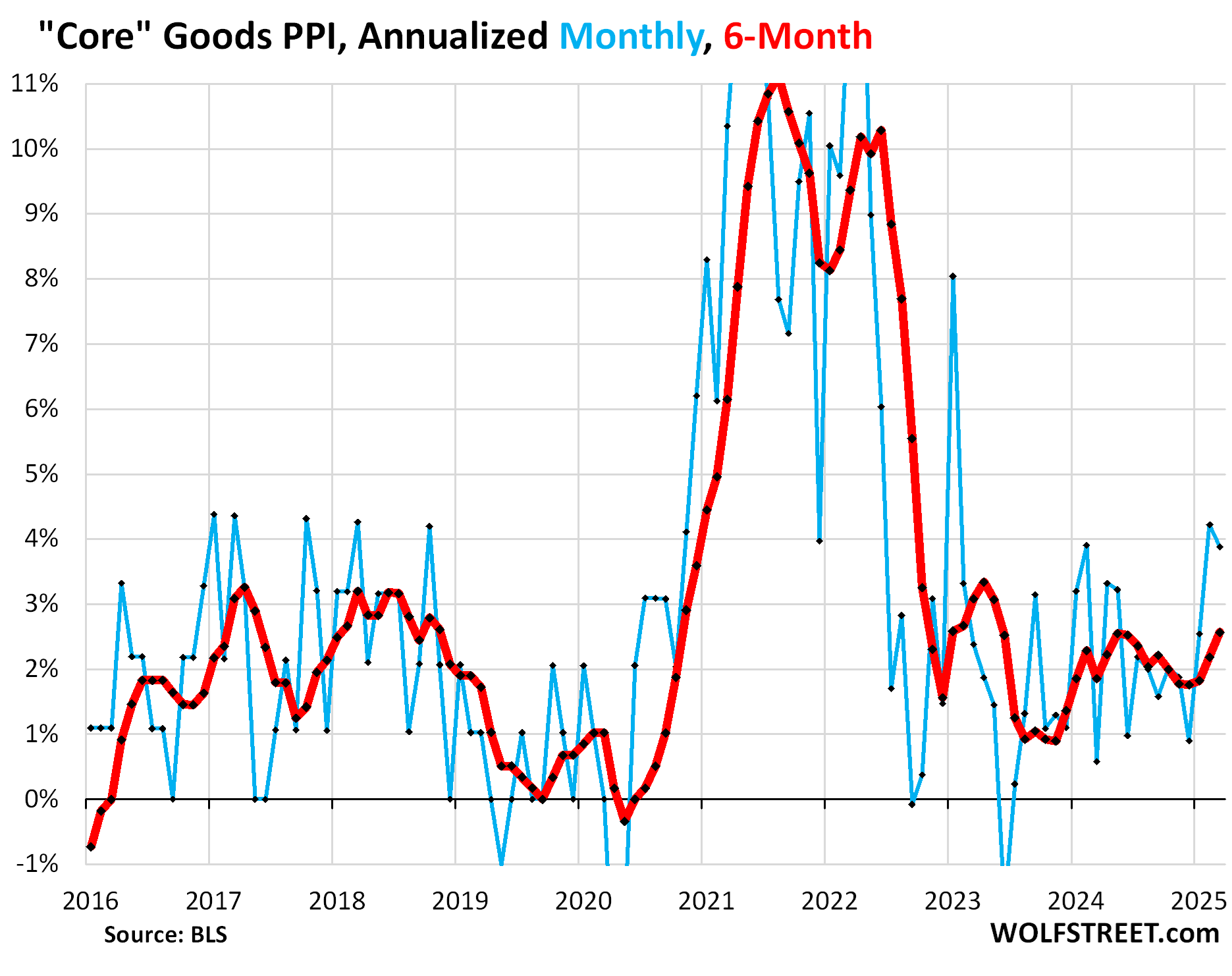
On a year-over-year basis, the core goods PPI rose by 2.4%. The visible steepening in the 12-month rate in March is a result of the 0.32% increase in March replacing the very low 0.05% increase of March 2024 (the “base effect”).
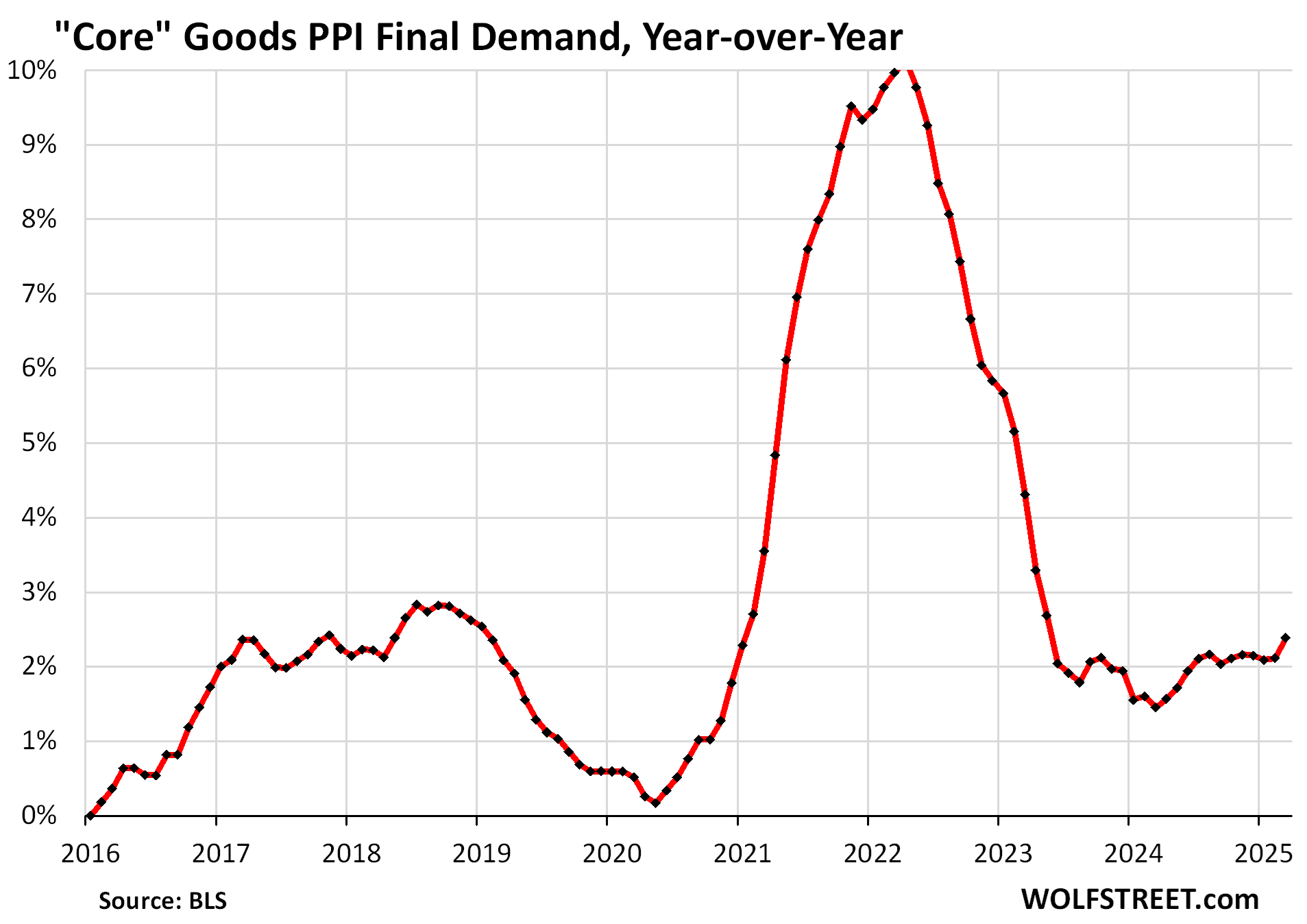
The PPI tracks the input costs for numerous specific industries. One of those industries is nonresidential construction. One segment of nonresidential construction that I tracked here, factory construction, has been in a mindboggling boom over the past three years, a result of the revival of high-end automated manufacturing in the US, and the huge amounts of investments that are being plowed into it.
As part of this factory construction boom, we also look at the PPI for nonresidential construction, which covers construction services as well as materials and supplies.
The PPI nonresidential construction had spiked horrendously in 2021 and 2022, but in 2023 and 2024 flattened out at high levels.
In March 2025, the price level of the PPI nonresidential construction was just a hair above where it had been two years earlier, in March 2023, with a sag in between (red line, left scale).
Month-to-month, the PPI nonresidential construction rose by 0.4% in March, following -0.1% in February and +0.6% in January.
Year-over-year, the PPI nonresidential construction rose by 2.1% in March (green line, right scale). After the surge during the pandemic, construction costs have proven to be very sticky overall, with some prices coming down, and others continuing to rise.
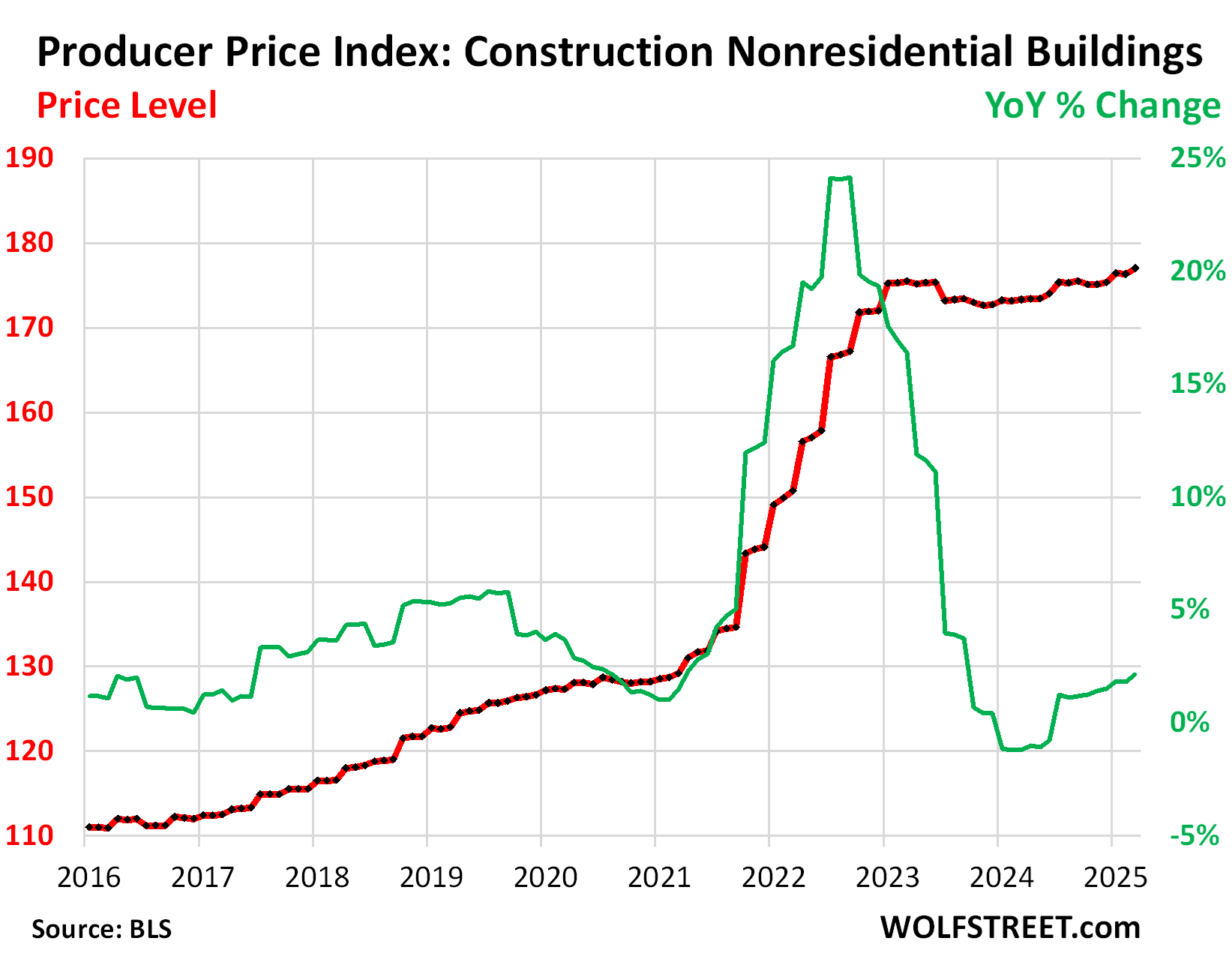
Enjoy reading WOLF STREET and want to support it? You can donate. I appreciate it immensely. Click on the mug to find out how:
![]()


Let’s see….If these tariffs stick especially for China, still not all that confident companies won’t try their hardest as long as there’s no buyer protest to raise prices…
Super anecdotal example and not applicable to all but saw this one popular adjustable dumbell set went from $1199 just 2 months ago to all of a sudden now $1399. Another example, for those familar with Fanatec in the sim racing world, they just had a across the board 20-30% price hike on everything and this is coming from a company that’s been reputationally damaged in the last couple of years so if they have the guts to try to pass the bucks….
What adjustable dumbbells are you looking at? That’s an insane price. This is what I bought and they are expandable up to 90lbs and some models have attachments for barbells.
REP x PÉPIN and even Nuobell is up there in price
If the retailer tells you that the dumbbell price increase was due to tariffs, they’re lying to you because the materials and products were in the US or on a ship to the US long before the new tariffs became effective, and therefor were NOT tariffed. Don’t ever buy from a retailer that is lying to you.
This is just regular price increases, and if you get enough of them, and people still buy at those prices, then it turns into regular inflation, which is what we still have now. No retailer price increases today are due to tariffs.
I’m struggling with this logic.
Just because I have a bunch of something in inventory, if the replacement cost is going to increase dramatically, why wouldn’t I adjust my prices to compensate for the higher replacement costs?
Let’s say have a bunch of comic books I bought as a kid and I open a store. If I sell everything (possibly even at a fat profit margin), but at a price that is too low to restock my shelves, I would then go out of business.
Just an example, but what business shouldn’t look at future replacement cost when it is setting its price targets?
You can do whatever you want and set your prices wherever you want and watch your sales collapse. Fine with me and everyone else. That’s how it is in business.
But if you’re telling your customers that you raised prices on your still non-tariffed merchandise and blame the tariffs for it, then YOU ARE LYING TO YOUR CUSTOMERS, and customers should never buy from a effing lying retailer.
And I’m right here telling all these customers out there that they’re being lied to if a retailer today blames the tariffs for current retail prices, and I’m telling these customers to never ever buy from an effing lying retailers.
When something, anything bumps up the world price of oil, all the signs at service stations announce their increase of the stuff that’s in their tank. It’s kind of amazing.
And then the price of gasoline plunges again. People forget or don’t notice the plunges. Gasoline prices fluctuate constantly. The average retail price in the US as of Monday was $3.21, down from $5.10 in June 2022. The first time gasoline went over $3 was in 2005 on its way to $4. The reason it plunged from the high is not because gas stations and refiners wanted to be nice to people, but because competition forced them to cut the price because they were losing business to competitors. But then it rises by 15 cents and everyone remembers to complain about that.
We’re already hearing ads on the radio
” Beat the tariff price increase sale”
The suckers are lining up to get fleeced. They deserve it.
Gasoline (Petrol) prices in Melbourne jumped overnight from A$1.67 a litre to A$2.07 a litre.
This is despite the A$ increasing and the price of crude falling like a rock over the recent past.
A 25% increase a week or so before the long Easter weekend holidays.
And of course it is “all down to market forces and prices”…..
Aussie Dollar increasing? Maybe a little after a multi year low.
Can always save petrol by stowing away in a roos’ pouch. Just expect a rough ride
When oil prices change, gasoline prices jump immediately but are very sticky on the way down.
Gas prices haven’t budged yet in California.
They didn’t out right announce it’s due to tariffs, at least not on their website, for the case of Fanatec they did blame it on tariffs. For the dumbell, it might or might not be the case driven by tariffs and they might or might not have them in stock already since they are constantly on pre-order status even since they came out so maybe they are making them certain batch at a time, in that case that tariffs will apply.
My point is, I just don’t trust majority of the companies won’t blame it on that to price gouge, it’s an easy excuse for them to pin it on something regardless of it being true or not. When one company does it, you can easily spot who’s lying and stop buying from them but when you and all your competitors are doing the same thing, then choice is limited or if you have a product that’s neck above your competitors in terms of pricing and quality then it’s easy for company to get away with pining the price increase on the boogie man.
I take the approach that I took when I lived overseas and everything was negotiated. Simply determine what something is worth to you and pay that. If not available at that price, but used or find a substitute. Seems like obvious advice but with so many willing to pay whatever then the prices will be too high.
Speaking for my own family, we long ago stopped eating out at restaurants. We buy just the basics at the grocery store. At Walmart & Amazon we buy only what is essential.
Spending $1,399 on dumbbells is…dumb. I offer $0.00.
Then again, I offer $0.00 for any crypto out there.
But, that’s just me, a typical working man who doesn’t buy into wall street bull shit.
Wall street equals snake oil salesmen.
Yes! $195.88 for 65in OLED TV’s incoming. Big TV in every room in America
Note to Wolf and readers – if a company DOESN’T pass on increased prices, they close their doors, PERMANENTLY. End of story.
Clueless. If they cannot pass on the tariffs, they simply operate on a lower profit margin (which are now at record highs) and they adjust to it. And their stock prices go down.
Did these companies pass on the tax CUTS they got? LOL NO. Those tax cuts just fattened up their profit margins, which is why profit margins are at record levels, and they have lots of room to eat tariffs for lunch and dinner.
I’ve heard for years from democrats that tax increases don’t mean price increases and now all of a sudden they are experts on tariffs
Corporate income tax increases (and decreases) are calculated on net income and aren’t a cost of production. There’s nothing to pass on. Sales taxes are a better example of taxes that increase prices.
THIS. Corporate free cash flow used to be 0-4% of GDP, for decades, but surged to 6-8% of GDP starting in 2008. You can graph this in FRED (John Hussman did, it’s in one of his 2 most recent articles).
That extra 5% of GDP is over a trillion dollars a year. Plenty of wiggle room for lower profit margins, at least in some parts of the economy.
To really get the most bang for the buck here, we also need antitrust enforcement reform. “3 consumer choices” is not adequate competition to prevent price gouging.
Also theoretically, all companies could operate with 0 profits but still exist.
Thanks for the straightforward answer on tariffs and the retailers that might lie. I’m sure they do and I’m sure with your vehicle dealers background you have seen and written about the retailers practices . Thanks again Wolf.
Exactly. I don’t know why people always assume tarriffs mean higher prices.
Did you fall off your motorbike?
That isn’t true at all. Companies have price increases all the time. Why are tariffs the only tax you people are concerned about? Lol
I’m not sure if it’s the only tax people care about, but the biggest tax increase in a generation is sure to get a lot of people talking.
I really don’t understand what the FED is waiting for except when they cut rates last time inflation spiked again.
What do you mean what they are waiting for? The 10 year US treasury has exploded to the upside again because of future inflation expectations because of tariffs.
The last time the Fed tried to get cute by cutting rates prematurely, yields on the long ended exploded higher. But thats right, go ahead fed, cut rates and further fuel inflation. And watch the 10 year blow right through 5 with ease.
Everything right now is about future inflation, not todays inflation. Its like some people dont get the fact that the democrats or republicans have next to ZERO control over the long yields. The bond market is its own animal and does what it wants to do. Trump and Musk can scream all they want, the bond market simply is not going to listen.
Yeah and I guess that is my point. The Fed didn’t give a shit about the rate cuts last year even though inflation wasn’t really tamed and never hit their 2% target. They cut when the job market got squishy and 900k jobs were revised out of existence.
It was bullshit.
The 10-year treasury has been at these levels pretty recently. I’m not worried about a 10-year yield of 4.5%. There are trillions of bonds rolling over this year…nearly $10 trillion so maybe the market wants more interest for their money. It’s all speculation.
Gas in the NW suburban Chicago was under $3 / gal last month and is now pushing $4.
I doesn’t matter one iota what happens at your corner gas station: This article is NOT about retail prices at your corner gas station.
What are the products that the US absolutely MUST import from China? Not food, not energy. Rare earth metals?
Couldn’t we go a whole with everyone just using up their existing TVs and toys? Keep the cell phone another year?
Really just rare earths and we have a lot of rare earths but we refuse to mine for them. We don’t have all of the rare earths though
That why we need to take over Greenland. The ice is melting and extraction time.
Instead of take over maybe we could engage in trade and partnership…. Crazy concept I know
Rare earths and fortune cookies. Other than that we’re good
Wolf could you explain the U.S. Census Bureau very recent graph that shows manufacturing construction decreasing since the start of 2025?
🤣 For the past 10 months through February, factory construction spending ran at an annual rate of about $235 billion, month after month, which is nearly THREE TIMES the run rate in 2019.
It moved up during the Biden years. Did he have anything to do with it? The chart does surprise me.
Jeff, I think Wolf is referencing the PPI charts in the original article and you’re referencing the factory construction spending chart in Wolf’s reply to Freedomnowandhow. My input to the factory construction spending chart is that is a follow on effect from the covid lockdowns. Companies need to bring production closer to home in order to have better control in times of global government overreach/disruptions.
Jack Hank,
thanks, I deleted my comment. In my commenting software, I don’t see what you see here, so I imagined – without checking in the heat of the battle — that he was referring to the more recent article about the dollar which has a chart that goes back four years. So my comment didn’t make any sense at all to anyone.
The census bureau doesn’t post graph data, monthly.
What kind of stupid bullshit are you STILL concocting? All you have to do is look at it. I don’t know why I still waste may time on your bullshit.
1. Obviously, the chart above is mine, created by me for WOLF STREET readers, based on Census data, MONTHLY
2. You can download the MONTHLY Census data directly from the Census Bureau, you can even choose what category of construction:
https://www.census.gov/econ/currentdata/dbsearch?programCode=VIP&startYear=2002&endYear=2025&categories%5B%5D=XXXX&dataType=T&geoLevel=US&adjusted=0¬Adjusted=1&errorData=0#table-results
Adios
Wolf, these people are just willfully dumb.
They dont care about trends. They care about spot data.
“Manufacturing has decreased since January”
Yeah after a historic run up
@Eric I think it is a mix of “willfully dumb” (the economy is in the tank because things are not going great for me and my dumb friends people) and the “partisan spin” people (who switch from pointing out positive economic data to negative econimic data depennding on the Presidents political party).
My Exxon “gas “station from hell is still posting same price $4.89 for regular that it had posted before all the drops in crude oil prices.
“Price gauging is still alive and well”. When will this insanity end?
How about buying a few gallons at one time. Behavior. Behavior. If all did the same it would look like demand cratered for these gas stations.
He must be reading Democrat talking points.
Glen,
We are going to invade Greenland & steal their fish.
Then we will invade Canada & steal their Maple syrup.
They will be sorry they messed with America.😊
Howdy Folks. Well it sure seems like the Youngins are watching and reading too much of the wrong thing. Wait and read future Wolf Street Articles while this plays out and you will learn about Tariffs. China steals not only American jobs, it cheats America by not following the rules we do…..About time a President makes Trade Farer for Americans……..
Not liking tariffs is fine but the hysteria is ridiculous.
Kevin O’Leary hates China. He has some great points.
Howdy Eric. The Lone Wolfs articles are spot on. Way above my pay grade most of the time, but most articles make sense to me. I listen to others ( Like Kevin Oleary ). and make up my own mind……
China cheats and lets hope we hold them accountable……..
Kevin O’Leary wants a 400% tariff on China.
Howdy Swamp. YEP, squish them like cockroaches. They cheat and steal from US.
In Canada the Chinese always manage to find loopholes in every law and every future enacted law. They’re crafty Trump better not underestimate them.
spelling…”farer” do you mean FAIRER? daar.
Howdy James. Misspellings is the best way to wead out Liberals.
That’s funny! And I’m pretty liberal!
Debt,was not this James!
I will add 1911 to me name,do not want to be confused with/identified as a progressive leberal!
China doesn’t steal jobs. American companies create them there, and in many other places, for lower labor costs. China does the same thing in places like Cambodia for the same reasons.
Rule breaking is universal as not like anybody pays attention to WTO or other bodies. American consumers have greatly benefitted from the lower cost of products from that labor and is now somehow enraged by it?
Remember that time when the 10 year was 4.8 in December and no one touted shit like “the US isn’t a reserve currency anymore” or “liquidity crisis”
I remember
Yeap that’s the new mantra now on financial channels. I wonder what narrative they will come up with next.
I think the increase in the 10 year could be a variety of factors.
One just normal fluctuations and heading back to the norm .
2. Increased borrowing from the large corps as they take on debt to fund the manufacturing reshore.
3. The liquidity change after the debt ceiling was raised and the USA checking account is getting refilled vs when they were depleting their reserves and running out of money .
Also maybe some liquidations to raise cash to pay income tax. That’s what I did this week .
Yeah I don’t buy the “oh Trump is making the US unreliable fiscal and blah blah”
First he is trying to cut spending so how is that fiscally irresponsible? (Whether it happens or not who knows)
Like everything is always a crisis in the news
He’s not trying to cut spending lol
He’s trying to cut taxes for the rich, that’s it.
The 10 year may be nosediving because the Chinese are dumping all of their long term bonds. The bet the bond vigilantees are warming up the bulpin.
That’s fine. If the Chinese are dumping they are doing the job of the FED who has stopped part of QT to a almost a standstill (at least for their part in treasuries). Deflation in China is strong so they cannot dump that much all together. Beside they have 700 billion left of treasuries or whatever.
I don’t think companies are concerned with onshoring manufacturing. By the time they do it, Trump will be gone (unless he stages a coup) before they even have a chance to complete onshoring. Why would a business owner spend all that money?
They are ALREADY spending that money. Onshoring is a huge thing now. Has been since 2021. See my chart above of spending on factory construction. There are announcements every day now of big new manufacturing plants getting started in the US.
Yes, can’t react to short term data points with generalizations but then again, most news articles today exist to generate ad revenue.
I’ve read that the increase in the 10 year was driven by lots of large hedge funds frantically selling treasuries to pay debts on losses in the stock market. Supposedly part of the reason Trump paused the tariff stuff. The selling might start a cascade of fear (queasy) in the market. Of course it might be BS and I might be misunderstanding what I’m reading.
The 10-year yield is back where it was a few weeks ago (mid-February) and is still too low for this inflationary environment. It should have never plunged like it did earlier this year, when it dropped from 4.8% to 3.8%. It’s now back to 4.5%, and just recovered part of the drop.
$1 Rigging and manipulation.
I’m personally coining a new word – ‘Wolfism’ (noun). A word which is tailor made or adapted to fit Wolf’s needs.
So, where did ‘a tax in corporate profit margins come from’? I saw several definitions which mostly said the same thing: In simple terms, a tariff is a tax imposed by a government on goods and services imported from
other countries, often used to protect domestic industries or raise revenue.
The word will appear in dictionaries in 2026.
PPI plunged, like a whole bunch of times before it. Even the moving average going down means nothing. Moving average shows higher highs and higher lows. It’s clearly still an up trend and policy should reflect that.
Agreed. As I pointed out, these month-to-month plunges are invariably followed, usually the next month, and sometimes the month after that, by a spike, and trend is maintained.
Mortgage rates surge over 7%…
Liquidity worsens in $29T Treasury market as volatility soars…
The thread title is regarding the ppi, but look where oil prices are in relation to inflation right now. We are basically at rock bottom 20 year low in oil prices unless you are including the small blip during covid which was short lived.
Do people seriously think oil price per barrel is going to stay like this long term unless there is a severe recession / depression? Seriously? Hanging out in the high 50s per barrel? Are people really this dumb to think Trump alone is going to keep worldwide oil prices at rock bottom levels for years and years to come without a severe recession / depression?
This is the entire problem in a nutshell. The cpi forecast next month is almost .3 with oil prices hanging out in the sewer at rock bottom levels. All its going to take to severely juice that inflation number next month and beyond is a rise in oil by a measly 20 bucks a barrel. Even 10 bucks a barrel more is going to create significant future inflation problems where things stand, and we dont even know where the tariff war is going to end yet with China let alone anyone else.
And people seriously cant figure out why long yields have rocketed higher. Seriously? It was a huge rise in oil prices that ultimately brought the US to its knees during the GFC. Yea, the mortgage and subprime market was a big part of it, but oil crushed it. Same thing with the oil embargo crises in the 70s which rocketed inflation higher.
In my humble opinion, the stock market is yet again still pricing things to perfection with rose colored glasses on. One major black swan event regarding oil and the entire fake economy built out of napkins and toothpicks will crash hard. Im riding with people like Michael Pento on this belief.
It would not surprise me in the least to see the fed make another massive blunder by cutting to early only to have to reverse course only to crash the economy even worse than 2009.
Ultimately, I think the bond market will break things anyway in time with the 10 year getting out of control.
Wolf, it seems to me that anyone who’s been intending to buy a new car this year is going to rush to the dealership to buy ahead of the tariff impact. And same for other big-ticket items with imported content.
As one who has a background in auto sales, what do you forsee?
Yes, there is a little bit of that. We saw some of that in March and Q1, and I discussed it here:
https://wolfstreet.com/2025/04/03/our-drunken-sailors-are-back-new-vehicle-sales-surge-in-march-after-rising-in-january-february-best-q1-since-2019/
Some consumers try to front-run events. But many don’t. Here are two of the reasons why many don’t or can’t front-run new-vehicle purchases:
1. Buying a new vehicle is often an impulse purchase (amazingly to me, but I saw that every day), and not planned months in advance. So these buyers don’t even think about front-running because they don’t even think about buying a vehicle, until they do, and then they buy right away. American consumers are trained that way.
2. Leases terminate on a fixed date, and so you cannot move that date forward to front-run anything. People are locked into the lease for the term. Leases are very popular. Many brands lease over half of what they sell. The German brands lease near or above 70% of what they sell. The rest is financed and cash.
And that’s kind of confirmed by what we saw in March: there was a little bit of front-running. But it was muddled by the big tax-refund season, with tax refunds outrunning those last year by a fairly good margin, and these tax refunds make great down payments. So that boosted sales as well. So it’s hard to see how much each contributed to the strong sales gain.
There was a little bit of front-running in 2018 too of affected products. I covered it at the time. And there was a little bit of a hangover in 2019, and I covered that. Most of the front-running was only clearly visible in the trucking sector that boomed in 2018 and hit a rough spot in 2019.